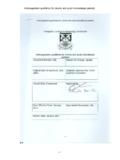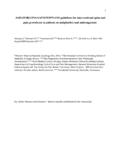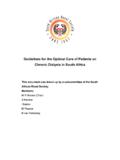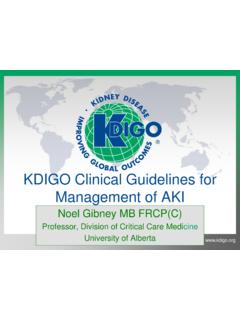Transcription of 2016ESCGuidelinesforthemanagementofatrial ...
1 ESC GUIDELINES2016 ESC guidelines for the management of atrialfibrillation developed in collaboration with EACTSThe Task Force for the management of atrial fibrillation of theEuropean Society of Cardiology (ESC)Developed with the special contribution of the European HeartRhythm Association (EHRA) of the ESCE ndorsed by the European Stroke Organisation (ESO)Authors/Task Force Members: Paulus Kirchhof (Chairperson) (UK/Germany),*Stefano Benussi*1(Co-Chairperson) (Switzerland), Dipak Kotecha (UK),Anders Ahlsson1(Sweden), Dan Atar (Norway), Barbara Casadei (UK),Manuel Castella1(Spain), Hans-Christoph Diener2(Germany), Hein Heidbuchel(Belgium), Jeroen Hendriks (The Netherlands), Gerhard Hindricks (Germany),Antonis S. Manolis (Greece), Jonas Oldgren (Sweden), Bogdan Alexandru Popescu(Romania), Ulrich Schotten (The Netherlands), Bart Van Putte1(The Netherlands),and Panagiotis Vardas (Greece)Document Reviewers: Stefan Agewall (CPG Review Co-ordinator) (Norway), John Camm (CPG ReviewCo-ordinator) (UK), Gonzalo Baron Esquivias (Spain), Werner Budts (Belgium), Scipione Carerj (Italy),Filip Casselman (Belgium), Antonio Coca (Spain), Raffaele De Caterina (Italy), Spiridon Deftereos (Greece),Dobromir Dobrev (Germany), Jose M.
2 Ferro (Portugal), Gerasimos Filippatos (Greece), Donna Fitzsimons (UK),*Corresponding authors: Paulus Kirchhof, Institute of Cardiovascular Sciences, University of Birmingham, SWBH and UHB NHS trusts, IBR, Room 136, Wolfson Drive, BirminghamB15 2TT, United Kingdom, Tel:+44 121 4147042, Stefano Benussi, Department of Cardiovascular Surgery, University Hospital Zurich, Ra mistrasse100, 8091 Zu rich, Switzerland, Tel:+41(0)788933835, the European Association for Cardio-Thoracic Surgery (EACTS)2 Representing the European Stroke Association (ESO)ESC Committee for Practice guidelines (CPG) and National Cardiac Societies Reviewers can be found in the entities having participated in the development of this document:Associations: European Association for Cardiovascular Prevention and Rehabilitation (EACPR), European Association of Cardiovascular Imaging (EACVI), European Heart RhythmAssociation (EHRA), Heart Failure Association (HFA).
3 Councils: Council on Cardiovascular Nursing and Allied Professions, Council for Cardiology Practice, Council on Cardiovascular Primary Care, Council on Groups: Cardiac Cellular Electrophysiology, Cardiovascular Pharmacotherapy, Grown-up Congenital Heart Disease, Thrombosis, Valvular Heart content of these European Society of Cardiology (ESC) guidelines has been published for personal and educational use only. No commercial use is authorized. No part of the ESCG uidelines may be translated or reproduced in any form without written permission from the ESC. Permission can be obtained upon submission of a written request to Oxford Uni-versity Press, the publisher of theEuropean Heart Journaland the party authorized to handle such permissions on behalf of the ESC ( The ESC guidelines represent the views of the ESC and were produced after careful consideration of the scientific and medical knowledge and the evidence available atthe time of their publication.)
4 The ESC is not responsible in the event of any contradiction, discrepancy and/or ambiguity between the ESC guidelines and any other official recom-mendations or guidelines issued by the relevant public health authorities, in particular in relation to good use of healthcare or therapeutic strategies. Health professionals are encour-aged to take the ESC guidelines fully into account when exercising their clinical judgment, as well as in the determination and the implementation of preventive, diagnostic ortherapeutic medical strategies; however, the ESC guidelines do not override, in any way whatsoever, the individual responsibility of health professionals to make appropriate andaccurate decisions in consideration of each patient s health condition and in consultation with that patient and, where appropriate and/or necessary, the patient s caregiver. Nordo the ESC guidelines exempt health professionals from taking into full and careful consideration the relevant official updated recommendations or guidelines issued by the competentpublic health authorities, in order to manage each patient s case in light of the scientifically accepted data pursuant to their respective ethical and professional obligations.
5 It is also thehealth professional s responsibility to verify the applicable rules and regulations relating to drugs and medical devices at the time of European Society of Cardiology 2016. All rights reserved. For permissions please email: Heart Journal (2016)37, 2893 2962 by guest on November 8, 2016 from Bulent Gorenek (Turkey), Maxine Guenoun (France), Stefan H. Hohnloser (Germany), Philippe Kolh (Belgium), (UK),AthanasiosManolis(Greece),JohnMcMur ray(UK),PiotrPonikowski(Poland),RaphaelR osenhek(Austria), Frank Ruschitzka (Switzerland), Irina Savelieva (UK), Sanjay Sharma (UK), Piotr Suwalski (Poland),Juan Luis Tamargo (Spain), Clare J. Taylor (UK), Isabelle C. Van Gelder (The Netherlands), Adriaan A. Voors (TheNetherlands), Stephan Windecker (Switzerland), Jose LuisZamorano (Spain), and Katja Zeppenfeld (The Netherlands)The disclosure forms of all experts involved in the development of these guidelines are available on the ESC Atrial fibrillation Anticoagulation Vitamin K antagonists Non-vitamin K antagonist oralanticoagulants Left atrial appendage occlusion Rate control Cardioversion Rhythm control Antiarrhythmic drugs Upstream therapy Catheter ablation AF surgery Valve repair Pulmonaryvein isolation Left atrial ablationTable of ContentsAbbreviations and acronyms.
6 41. Preamble ..52. Introduction ..73. Epidemiology and impact for patients .. Incidence and prevalence of atrial fibrillation .. Morbidity, mortality, and healthcare burden of atrialfibrillation .. Impact of evidence-based management on outcomes inatrial fibrillation patients .. Gender ..94. Pathophysiological and genetic aspects that guide Genetic predisposition .. Mechanisms leading to atrial fibrillation .. Remodelling of atrial structure and ion channelfunction .. Electrophysiological mechanisms of atrial fibrillation . Focal initiation and maintenance of atrialfibrillation .. The multiple wavelet hypothesis and rotors assources of atrial fibrillation .. 105. Diagnosis and timely detection of atrial fibrillation .. Overt and silent atrial fibrillation .. Screening for silent atrial fibrillation .. Screening for atrial fibrillation by electrocardiogram inthe community.
7 Prolonged monitoring for paroxysmal atrialfibrillation .. Patients with pacemakers and implanted devices .. Detection of atrial fibrillation in stroke survivors .. Electrocardiogram detection of atrial flutter ..136. Classification of atrial fibrillation .. Atrial fibrillation pattern .. Atrial fibrillation types reflecting different causes of thearrhythmia .. Symptom burden in atrial fibrillation ..147. Detection and management of risk factors and concomitantcardiovascular diseases .. Heart failure .. Patients with atrial fibrillation and heart failure withreduced ejection fraction .. Atrial fibrillation patients with heart failure withpreserved ejection fraction .. Atrial fibrillation patients with heart failure with mid-range ejection fraction .. Prevention of atrial fibrillation in heart failure .. Hypertension .. Valvular heart disease.
8 Diabetes mellitus .. Obesity and weight loss .. Obesity as a risk factor .. Weight reduction in obese patients with atrialfibrillation .. Catheter ablation in obese patients .. Chronic obstructive pulmonary disease, sleep apnoea, andother respiratory diseases .. Chronic kidney disease ..198. Integrated management of patients with atrial fibrillation .. Evidence supporting integrated atrial fibrillation care .. Components of integrated atrial fibrillation care .. Patient involvement .. Multidisciplinary atrial fibrillation teams .. Role of non-specialists .. Technology use to support atrial fibrillation care .. Diagnostic workup of atrial fibrillation patients .. Recommended evaluation in all atrial fibrillationpatients .. Additional investigations in selected patients withatrial fibrillation .. Structured follow-up .. Defining goals of atrial fibrillation management.
9 229. Stroke prevention therapy in atrial fibrillation patients .. Prediction of stroke and bleeding risk .. Clinical risk scores for stroke and systemic Anticoagulation in patients with a CHA2DS2-VAScscore of 1 in men and 2 in women .. Clinical risk scores for bleeding .. 23 ESC GuidelinesOnline publish-ahead-of-print 27 August 20162894 by guest on November 8, 2016 from Stroke prevention .. Vitamin K antagonists .. Non-vitamin K antagonist oral anticoagulants .. Apixaban .. Dabigatran .. Edoxaban .. Rivaroxaban .. Non-vitamin K antagonist oral anticoagulants orvitamin K antagonists .. Oral anticoagulation in atrial fibrillation patients withchronic kidney disease .. Oral anticoagulation in atrial fibrillation patients ondialysis .. Patients with atrial fibrillation requiring kidneytransplantation .. Antiplatelet therapy as an alternative to oralanticoagulants.
10 Left atrial appendage occlusion and exclusion .. Left atrial appendage occlusion devices .. Surgical left atrial appendage occlusion or exclusion . Secondary stroke prevention .. Treatment of acute ischaemic stroke .. Initiation of anticoagulation after transient ischaemicattack or ischaemic stroke .. Initiation of anticoagulation after intracranialhaemorrhage .. Strategies to minimize bleeding on anticoagulant Uncontrolled hypertension .. Previous bleeding event .. Labile international normalized ratio and adequatenon-vitamin K antagonist oral anticoagulant dosing .. Alcohol abuse .. Falls and dementia .. Genetic testing .. Bridging periods off oral anticoagulation .. Management of bleeding events in anticoagulated patientswith atrial fibrillation .. Management of minor, moderate, and severebleeding .. Oral anticoagulation in atrial fibrillation patients at riskof or having a bleeding event.







